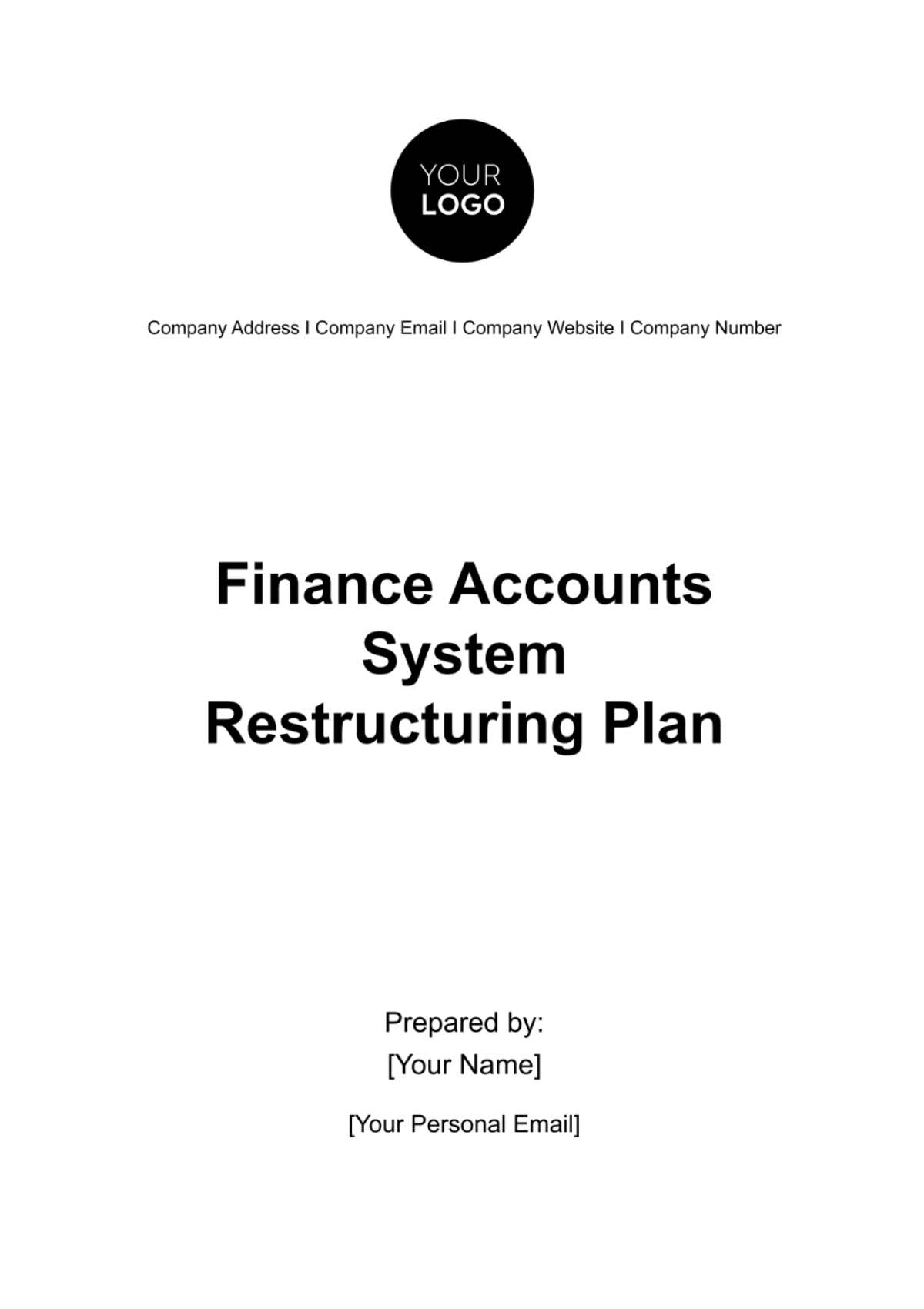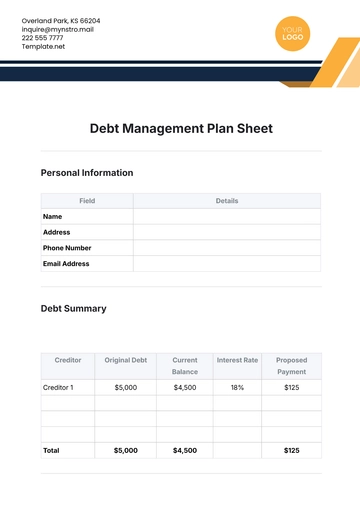Free Finance Accounts System Restructuring Plan

Executive Summary
The Finance Accounts System Restructuring Plan represents a critical initiative for [Your Company Name], designed to significantly upgrade its financial management and reporting capabilities. In the dynamic business environment of today, having a robust, efficient, and compliant financial system is not just a need but a strategic imperative. This plan is meticulously crafted to address the current limitations and future needs of the company's financial operations.
Our primary objective is to streamline the financial processes, ensuring they are more efficient, accurate, and in strict adherence to the evolving regulatory standards. This overhaul is not merely a technical upgrade but a transformational shift in how [Your Company Name] handles its financial data and reporting.
The restructuring plan is comprehensive, encompassing several critical phases: initial assessment, system selection, customization, data migration, staff training, system testing, and final implementation. Each phase has been thoughtfully designed to transition smoothly from the current state to a more advanced, user-friendly, and compliant system.
With this restructuring, [Your Company Name] aims to achieve key outcomes: a significant reduction in manual processes through automation, heightened accuracy in financial reporting, ensuring up-to-date compliance with all financial regulations, and enhancing the security of sensitive financial data.
Investing in this restructuring plan is not just an upgrade; it's a strategic move towards future-proofing the financial backbone of the company, aligning it with the best practices in financial management, and positioning [Your Company Name] for sustainable growth and success.
Current State Analysis
The Current State Analysis serves as the foundation for the Finance Accounts System Restructuring Plan. This chapter aims to provide a comprehensive overview of the existing financial systems at [Your Company Name], identifying the challenges and limitations inherent in the current setup, and evaluating the company's compliance with relevant financial regulations. This analysis is critical in understanding the gaps in the current system and forms the basis for the proposed restructuring plan.
Aspect | Description |
|---|---|
Existing Systems | Utilizes traditional software (XYZ Accounting Pro) with basic functionalities. Lacks integration with CRM and supply chain systems, leading to data discrepancies. |
Challenges & Limitations | Manual Data Entry: High reliance, causing inefficiencies and errors. Reporting Capabilities: Limited customization options, impeding financial analysis. Scalability Issues: Struggles with increasing transaction volumes. User Experience: Outdated interface, decreasing productivity and increasing staff training needs. |
Regulatory Compliance | Partial compliance with financial regulations. Gaps in tax reporting and IFRS adherence. Risk of non-compliance due to inability to update with new regulations. |
Objectives
The primary objectives of the Finance Accounts System Restructuring Plan for [Your Company Name] are centered around four key areas:
Enhance Efficiency: Our goal is to automate and streamline accounting processes to reduce time-consuming manual tasks. By leveraging technology, we aim to expedite financial operations, enabling more efficient resource allocation and decision-making.
Improve Accuracy: The implementation of advanced systems is designed to minimize human errors. Accuracy in financial reporting is crucial for reliable decision-making and maintaining the company's credibility.
Ensure Compliance: Staying aligned with financial regulatory requirements is a priority. The new system will ensure that [Your Company Name] consistently meets legal standards, thereby avoiding potential legal complications and penalties.
Data Security: Given the sensitive nature of financial data, strengthening its security is imperative. The planned enhancements will safeguard against data breaches and unauthorized access, thus protecting the company's financial integrity.
Proposed System Features
The proposed restructuring of the Finance Accounts System at [Your Company Name] includes the introduction of several key features. These features are designed to directly address the objectives outlined above, offering substantial benefits to the company's financial operations. The implementation of these features will contribute significantly to the overall effectiveness and efficiency of the finance department.
Feature | Benefit |
|---|---|
Automated Data Entry | Significantly reduces manual errors and saves time by automating data input processes. This feature will streamline data entry tasks, allowing staff to focus on more strategic activities. |
Real-Time Reporting | Provides up-to-date financial information, enabling prompt and informed decision-making. This feature ensures that financial reports reflect the most current data, enhancing the accuracy of financial analysis. |
Compliance Management | Ensures strict adherence to financial regulations and standards. This system feature will automatically update to reflect changes in regulations, thereby reducing the risk of non-compliance. |
Enhanced Security | Implements advanced security protocols to protect sensitive financial data. This includes encryption, access controls, and regular security audits, thereby safeguarding against data breaches and unauthorized access. |
These proposed system features are integral to achieving the objectives set forth in the restructuring plan, and they represent a significant step forward in the technological evolution of [Your Company Name]'s financial management.
Implementation Plan
The successful implementation of the Finance Accounts System Restructuring Plan at [Your Company Name] involves a structured and phased approach. This approach is designed to ensure a seamless transition from the current systems to the new, more efficient system. Each phase of the implementation is critical and builds upon the success of the previous phase. The plan is comprehensive, addressing aspects from system selection to final deployment, ensuring that each step is executed with precision and aligns with the overall objectives of the restructuring.
Table of Implementation Phases:
Phase | Description | Key Actions |
|---|---|---|
Phase 1: System Selection | This phase involves identifying and selecting the most suitable accounting software for [Your Company Name]. | Research various accounting software options. Evaluate features, compatibility, and cost. Select the software that aligns with the company's needs and budget. |
Phase 2: System Setup and Customization | The chosen system is set up and customized to fit the specific accounting processes of the company. | Customize the software to match company-specific processes. Establish user roles and permissions for enhanced data security. |
Phase 3: Data Migration | Critical phase where existing financial data is transferred to the new system. | Migrate financial data from the old to the new system. Validate data accuracy and integrity during migration. |
Phase 4: Training and Development | Staff members are trained, and support materials are developed to facilitate the transition to the new system. | Conduct training sessions on the new system functionalities. Develop a comprehensive user manual. Provide ongoing support to staff. |
Phase 5: System Testing and Go-Live | Final phase where the new system is thoroughly tested and then officially launched. | Perform extensive testing to ensure system reliability and performance. Address any issues identified during testing. Officially launch the new system for operational use. |
This structured approach to implementation will ensure that [Your Company Name] transitions smoothly to the new finance accounts system, minimizing disruption to the business and maximizing the benefits of the new system.
Budget Estimation
The budget estimation for the Finance Accounts System Restructuring at [Your Company Name] is a crucial component of the planning process. It outlines the anticipated financial investment required to successfully implement the new system. This estimation covers various aspects of the implementation, including the acquisition of software licenses, system customization, data migration, staff training and development, and miscellaneous expenses that may arise during the process. An accurate budget plan is essential to ensure that the project has the necessary financial resources for completion without unexpected financial overruns.
Budget Estimation Table:
Item | Estimated Cost |
|---|---|
Accounting Software License | $25,000 |
System Customization | $15,000 |
Data Migration | $10,000 |
Training & Development | $8,000 |
Miscellaneous Expenses | $5,000 |
Total | $63,000 |
Risks and Mitigation Strategies
Identifying potential risks and developing mitigation strategies is a critical aspect of the Finance Accounts System Restructuring Plan. This proactive approach ensures that [Your Company Name] is prepared to address challenges effectively as they arise during the implementation process. The following are key risks identified along with their corresponding mitigation strategies:
Risks and Mitigation Strategies Table:
Risk | Mitigation Strategy |
|---|---|
Data Migration Errors | Employ data validation tools to ensure accuracy. Maintain a backup of the existing system to safeguard against data loss. |
Resistance to Change among Staff | Implement comprehensive training programs to facilitate staff adaptation to the new system. Involve staff in the transition process to increase buy-in and reduce resistance. |
System Downtime during Transition | Plan the transition during periods of low business activity to minimize impact. Develop contingency plans to address potential downtimes efficiently. |
By addressing these risks with targeted strategies, [Your Company Name] can ensure a smoother transition to the new finance accounts system, minimizing disruptions to the business operations and maximizing the benefits of the system upgrade.
Conclusion
The comprehensive restructuring of the Finance Accounts System marks a pivotal moment in the journey of [Your Company Name] towards financial excellence. This meticulously crafted plan is not merely a technological upgrade; it is a strategic realignment of our financial management practices to meet and exceed the demands of the modern business landscape.
By embracing this change, [Your Company Name] is set to reap significant benefits. The automation and streamlining of accounting processes will catapult our operational efficiency to new heights, freeing up valuable resources and time. The enhanced accuracy of our financial reporting, underpinned by robust, state-of-the-art systems, will fortify the trust and credibility we hold with our stakeholders.
Moreover, strict adherence to regulatory compliance will not only safeguard us against legal and financial risks but will also reinforce our commitment to ethical business practices. The bolstered security measures will protect our most sensitive financial data, an asset of inestimable value in this digital age.
As we embark on this transformative journey, the positive ripple effects of these changes will be felt across the entire organization. Improved financial insights will empower more informed decision-making at all levels, fostering a culture of transparency and strategic foresight.
In conclusion, the Finance Accounts System Restructuring Plan is more than an initiative; it is a fundamental shift towards a future where [Your Company Name] is not just keeping pace but setting the standard in financial management. It is an investment in our sustainability, growth, and continued success.
- 100% Customizable, free editor
- Access 1 Million+ Templates, photo’s & graphics
- Download or share as a template
- Click and replace photos, graphics, text, backgrounds
- Resize, crop, AI write & more
- Access advanced editor
Template.net offers an editable Finance Accounts System Restructuring Plan Template that simplifies the process of revamping your financial infrastructure. This meticulously crafted template streamlines your accounting system, ensuring efficiency and compliance. With comprehensive sections and customizable features using our AI editor tool, it's your go-to tool for a seamless financial overhaul. Simplify restructuring with Template.net's expertly designed template today!
You may also like
- Finance Plan
- Construction Plan
- Sales Plan
- Development Plan
- Career Plan
- Budget Plan
- HR Plan
- Education Plan
- Transition Plan
- Work Plan
- Training Plan
- Communication Plan
- Operation Plan
- Health And Safety Plan
- Strategy Plan
- Professional Development Plan
- Advertising Plan
- Risk Management Plan
- Restaurant Plan
- School Plan
- Nursing Home Patient Care Plan
- Nursing Care Plan
- Plan Event
- Startup Plan
- Social Media Plan
- Staffing Plan
- Annual Plan
- Content Plan
- Payment Plan
- Implementation Plan
- Hotel Plan
- Workout Plan
- Accounting Plan
- Campaign Plan
- Essay Plan
- 30 60 90 Day Plan
- Research Plan
- Recruitment Plan
- 90 Day Plan
- Quarterly Plan
- Emergency Plan
- 5 Year Plan
- Gym Plan
- Personal Plan
- IT and Software Plan
- Treatment Plan
- Real Estate Plan
- Law Firm Plan
- Healthcare Plan
- Improvement Plan
- Media Plan
- 5 Year Business Plan
- Learning Plan
- Marketing Campaign Plan
- Travel Agency Plan
- Cleaning Services Plan
- Interior Design Plan
- Performance Plan
- PR Plan
- Birth Plan
- Life Plan
- SEO Plan
- Disaster Recovery Plan
- Continuity Plan
- Launch Plan
- Legal Plan
- Behavior Plan
- Performance Improvement Plan
- Salon Plan
- Security Plan
- Security Management Plan
- Employee Development Plan
- Quality Plan
- Service Improvement Plan
- Growth Plan
- Incident Response Plan
- Basketball Plan
- Emergency Action Plan
- Product Launch Plan
- Spa Plan
- Employee Training Plan
- Data Analysis Plan
- Employee Action Plan
- Territory Plan
- Audit Plan
- Classroom Plan
- Activity Plan
- Parenting Plan
- Care Plan
- Project Execution Plan
- Exercise Plan
- Internship Plan
- Software Development Plan
- Continuous Improvement Plan
- Leave Plan
- 90 Day Sales Plan
- Advertising Agency Plan
- Employee Transition Plan
- Smart Action Plan
- Workplace Safety Plan
- Behavior Change Plan
- Contingency Plan
- Continuity of Operations Plan
- Health Plan
- Quality Control Plan
- Self Plan
- Sports Development Plan
- Change Management Plan
- Ecommerce Plan
- Personal Financial Plan
- Process Improvement Plan
- 30-60-90 Day Sales Plan
- Crisis Management Plan
- Engagement Plan
- Execution Plan
- Pandemic Plan
- Quality Assurance Plan
- Service Continuity Plan
- Agile Project Plan
- Fundraising Plan
- Job Transition Plan
- Asset Maintenance Plan
- Maintenance Plan
- Software Test Plan
- Staff Training and Development Plan
- 3 Year Plan
- Brand Activation Plan
- Release Plan
- Resource Plan
- Risk Mitigation Plan
- Teacher Plan
- 30 60 90 Day Plan for New Manager
- Food Safety Plan
- Food Truck Plan
- Hiring Plan
- Quality Management Plan
- Wellness Plan
- Behavior Intervention Plan
- Bonus Plan
- Investment Plan
- Maternity Leave Plan
- Pandemic Response Plan
- Succession Planning
- Coaching Plan
- Configuration Management Plan
- Remote Work Plan
- Self Care Plan
- Teaching Plan
- 100-Day Plan
- HACCP Plan
- Student Plan
- Sustainability Plan
- 30 60 90 Day Plan for Interview
- Access Plan
- Site Specific Safety Plan





























